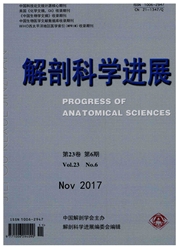

 中文摘要:
中文摘要:
目的观察创伤后应激障碍(PTSD)大鼠前额皮质钙网蛋白(calretinculin,CRT)的表达变化,旨在揭示PTSD部分发病机制。方法取健康成年雄性Wistar大鼠75只,随机分为连续单一刺激(singleprolongedstress,SPS)模型1d、4d、7d、14d和正常对照组,用免疫组织化学法、免疫印迹法和RT—PCR法检测PTSD内侧前额皮质(mediaprefrontalcortex,mPFC)CRT的表达变化。结果在正常大鼠脑mPFC神经细胞中有CRT的表达,与对照组相比sPs刺激后CRT表达有增高趋势,mRNA和蛋白水平从SPSld开始增多,SPS4d达到高峰,SPS7d组和SPS14d组有降低趋势,但仍高于正常组。结论CRT在SPS大鼠mPFC过表达提示其可能参与PTSD大鼠记忆情绪改变的病理生理学机制。
 英文摘要:
英文摘要:
Objective To observe the change of calretinculin(CRT) expression in the medial prefrontal cortex of posttraumatic stress disorder(PTSD) rats to reveal part of the pathogensis. Methods The single prolonged stress(SPS) method was used to set up the PTSD models. A total of 75 male Wistar rats were randomly divided into ld, 4d, 7d, 14d groups of SPS and the normal control group. The expression of CRT was detected by using immunofluorescence, Western blot and RT-PCR. Results The expression levels of CRT mRNA and protein in media prefrontal cortex were increased l d after SPS and reached the maximum at 4d after SPS compared with normal control, then decreased at 4d after SPS but still higher than in normal control. Conclusion The overexpression of CRT in media prefrontal cortex in SPS rats may be related to the pathogenesis of PTSD.
 同期刊论文项目
同期刊论文项目
 同项目期刊论文
同项目期刊论文
 期刊信息
期刊信息
